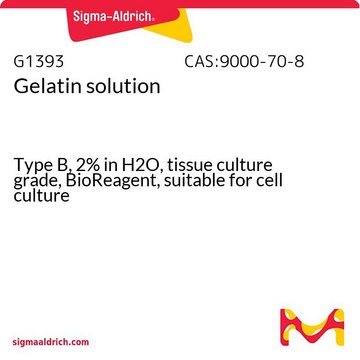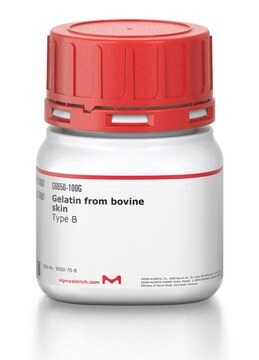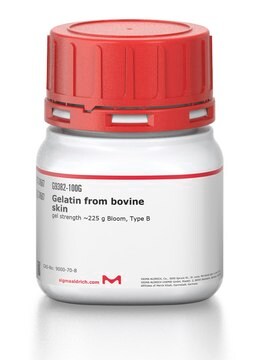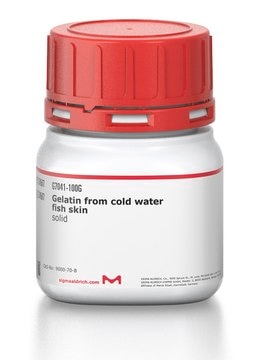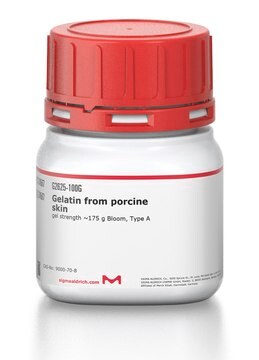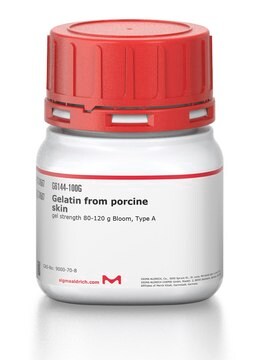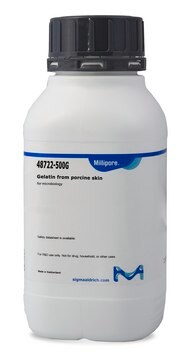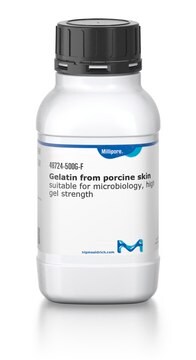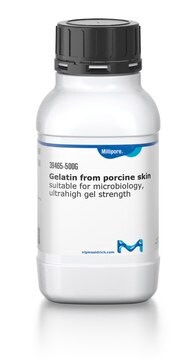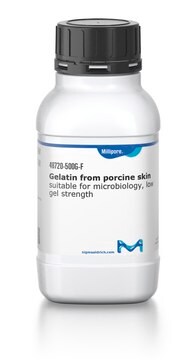G9391
Bovine Gelatin
from bovine skin, Type B, powder, suitable for cell culture
About This Item
Productos recomendados
Nombre del producto
Gelatin from bovine skin, Type B, powder, BioReagent, suitable for cell culture
origen biológico
bovine skin
Nivel de calidad
esterilidad
sterile
tpo
Type B
Línea del producto
BioReagent
Formulario
powder
envase
pkg of 100 g
pkg of 500 g
técnicas
cell culture | mammalian: suitable
fuerza de gel
~225 g Bloom
solubilidad
H2O: soluble 50 mg/mL, hazy to strongly hazy, faintly yellow to yellow
Condiciones de envío
ambient
temp. de almacenamiento
room temp
¿Está buscando productos similares? Visita Guía de comparación de productos
Descripción general
Aplicación
- in coating cell culture to improve attachment of cells,
- in PCR to stabilize Taq DNA, as a blocking reagent in Western blotting, ELISA, and immunochemistry,
- as a component of media for species differentiation in bacteriology
- as a biocompatible polymer
- as a delivery vehicle for the release of active biomolecules
- in the generation of scaffolds for tissue engineering applications.
- to study long-chain fatty acid-induced changes in gene expression in neonatal cardiac monocytes
- to study to test mobilization of capillary endothelium in-vitro induced by effectors of angiogenesis in vivo
Acciones bioquímicas o fisiológicas
Componentes
Precaución
Nota de preparación
Código de clase de almacenamiento
11 - Combustible Solids
Clase de riesgo para el agua (WGK)
nwg
Punto de inflamabilidad (°F)
Not applicable
Punto de inflamabilidad (°C)
Not applicable
Equipo de protección personal
Eyeshields, Gloves, type N95 (US)
Elija entre una de las versiones más recientes:
¿Ya tiene este producto?
Encuentre la documentación para los productos que ha comprado recientemente en la Biblioteca de documentos.
Los clientes también vieron
Artículos
Attachment Factors for 3-Dimensional Cell Culture
The extracellular matrix (ECM) is secreted by cells and surrounds them in tissues.
Cancer stem cell media, spheroid plates and cancer stem cell markers to culture and characterize CSC populations.
Nuestro equipo de científicos tiene experiencia en todas las áreas de investigación: Ciencias de la vida, Ciencia de los materiales, Síntesis química, Cromatografía, Analítica y muchas otras.
Póngase en contacto con el Servicio técnico
